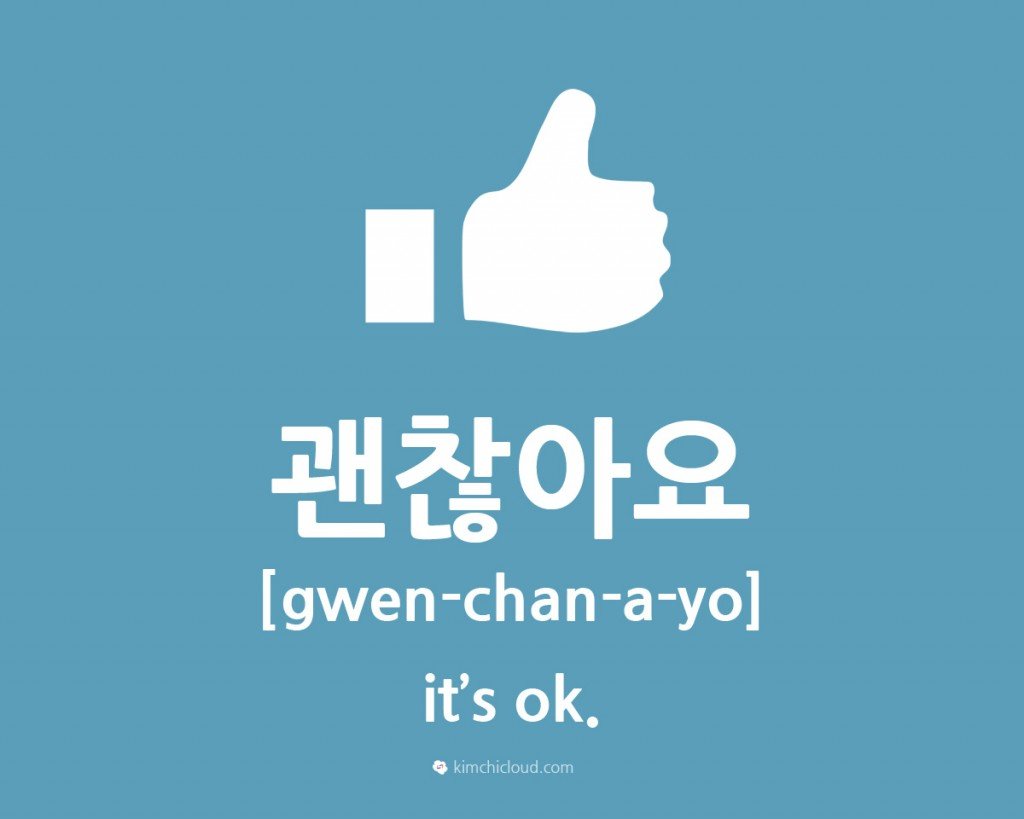괜찮아요 – How To Say Okay in Korean
Okay in Korean
In this lesson, we will learn how to say “okay” in Korean. There are a few ways in which you can do this and, just like in English, the meaning of the word will depend on the situation. It can be used to tell someone you are fine, to acknowledge a fact or statement or to say “no thanks”. Furthermore, it can be used to say that something is good or “not bad”, like “the concert was ok”. Anyway, let’s get started!
1. I’m / it’s Okay
This first meaning can be used in many different situations and we express it with the word gwenchanta (괜찮다), which is the dictionary form. You can use this to answer when someone asks you how you are or describing something acceptable or adequate, something that’s not bad but could be better. Furthermore, as a question, it can be used to seek confirmation (“is this okay?”).
We have introduced the dictionary form of the word used above, but in order to actually use it in a real situation, it needs to be conjugated. In Korean, there are different politeness levels and you conjugate the verbs and adjectives to match the person to whom you are talking. So let’s take a look at how to actually use this word, shall we?
The polite way
gwenchanayo
in Hangul: 괜찮아요
This is the polite way to say “I’m OK” or “it’s OK” in Korean. If you are unsure, which most beginners are, about what politeness level to use, you should always use this one. It will make you come off as polite and well-mannered, making it safe to use in every situation. If you’re talking to close friends and siblings, however, it can sound slightly awkward. In proper Korean, you should use this when talking to:
- teachers
- bosses
- grandparents
- people who are not close friends
- older people in general
Now, let’s take a look what to use when you are talking to your close friends.
The familiar/casual way
gwenchana
in Hangul: 괜찮아
You should use “gwenchana” (괜찮아) when you are talking to people with whom you are close. This includes:
- your close friends
- your siblings
- people who are clearly younger than you, like kids
- your parents (traditionally you would not but the new generation of Koreans do)
The most formal way
gwenchansumnida
in Hangul: 괜찮습니다
Finally, we have the most formal way. It’s primarily used, as implied, in formal situations like speeches and presentations, as well as the news on television. As a beginner, you are unlikely to use this form unless you are taking classes in Korean, but you will still encounter it a lot if you expose yourself to the Korean language.
Examples
Ex. 1
A: 어땠어요?
[eo-ddaess-eo-yo]
= How was it?
B: 괜찮았어요.
[gwen-chan-ass-eo-yo]
= It was okay.
Ex. 2
괜찮은데…
[gwen-chan-eun-de]
= it’s ok but…
Ex. 3
A: 괜찮아요?
[gwen-chan-a-yo]
= Is it ok?
B: 괜찮아요.
[gwen-chan-a-yo]
= It’s ok. (you can also say this to calm someone down. Like, “don’t worry, it’s okay.”)
gwenchanayo (괜찮아요) can also mean “no thanks”.
Ex. 4
A: 봉투에 담아 드릴까요?
[bong-tu-eh dam-a deu-ril-kka-yo]
= Do you need a plastic bag?
B: (아니요) 괜찮아요.
[(a-ni-yo) gwen-chan-a-yo]
= No thanks.
2. “OK”, meaning “Yes”
To acknowledge and let the other person know that you understand what they said to, or asked of, you, you use the word “neh” (네) meaning “yes” and we recommend you to check out our specific lesson on how to say “yes” in Korean for more information about that word.
neh (in Hangul: neh) – polite, formal
eung (in Hangul: 응) – familiar/casual
You can also use the word “algesseoyo” (알겠다), meaning “I understand”(this word is a conjugated form of “al-da” (알다), meaning “to know” but don’t worry about that). The same rules apply here as with gwenchanda (괜찮다) so how we conjugate it will depend on the person you’re talking to.
algesseoyo (in Hangul: 알겠어요) – polite
algesseo (in Hangul: 알겠어) – familiar/casual
algessumnida (in Hangul: 알겠습니다) – formal
Examples
Ex. 1
A: 기다려 주세요.
[gidaryeo juseyo]
= Please wait.
B1: 네.
[neh]
= Okay.
B2: 알겠어요.
[algesseoyo]
= Okay.
3. “OK”, meaning “good/I like it”
When you want to let the other person know that you understand what they said but also want to make him or her know that you like the idea, or have a positive attitude towards what they asked of you, you can use the word johda (좋다) which translates directly to “it’s good” or “I like it”. Just like the other words, it needs to be conjugated.
johayo (in Hangul: 좋아요) – polite
joha (in Hangul: 좋아) – familiar/casual
johsumnida (in Hangul: 좋습니다) – formal
Examples
Ex. 1
A: 밥 먹자.
[bap meok-ja]
= Let’s eat (informal)
B: 좋아.
[joha]
= Okay, sounds good.
Check out this song by BTOB to hear the word in action. Memorizing lyrics from a song is a good way to internalize and learn words.
This is all you need to know in order to say “okay” in Korean. For more lessons like this one, please check out our Everyday Korean archive! If you have any questions or something else on your mind, make sure to leave a comment below and we will do our best to help you out! If you found this lesson helpful, please like or share. ^^
By: Kimchi Cloud





